Keithley 2100 User Manual

www.keithley.com
Model 2100 6 1/2-Digit Resolution
Digital Multimeter
User’s Manual
2100-900-01 Rev. C / August 2010
A G R E A T E R M E A S U R E O F C O N F I D E N C E
Model 2100
6 1/2-Digit Resolution Digital Multimeter
User’s Manual
©2007-2010, Keithley Instruments, Inc.
All rights reserved.
Cleveland, Ohio, U.S.A.
Document Number: 2100-900-01 Rev. C / August 2010

Safety Precautions
The following safety precautions should be observed before using this product and any associated instrumentation. Although some instruments and accessories would normally be used with non-hazardous voltages, there are situations where hazardous conditions may be present.
This product is intended for use by qualified personnel who recognize shock hazards and are familiar with the safety precautions required to avoid possible injury. Read and follow all installation, operation, and maintenance information carefully before using the product. Refer to the user documentation for complete product specifications.
If the product is used in a manner not specified, the protection provided by the product warranty may be impaired.
The types of product users are:
Responsible body is the individual or group responsible for the use and maintenance of equipment, for ensuring that the equipment is operated within its specifications and operating limits, and for ensuring that operators are adequately trained.
Operators use the product for its intended function. They must be trained in electrical safety procedures and proper use of the instrument. They must be protected from electric shock and contact with hazardous live circuits.
Maintenance personnel perform routine procedures on the product to keep it operating properly, for example, setting the line voltage or replacing consumable materials. Maintenance procedures are described in the user documentation. The procedures explicitly state if the operator may perform them. Otherwise, they should be performed only by service personnel.
Service personnel are trained to work on live circuits, perform safe installations, and repair products. Only properly trained service personnel may perform installation and service procedures.
Keithley Instruments products are designed for use with electrical signals that are rated Measurement Category I and Measurement Category II, as described in the International Electrotechnical Commission (IEC) Standard IEC 60664. Most measurement, control, and data I/O signals are Measurement Category I and must not be directly connected to mains voltage or to voltage sources with high transient over-voltages. Measurement Category II connections require protection for high transient over-voltages often associated with local AC mains connections. Assume all measurement, control, and data I/O connections are for connection to Category I sources unless otherwise marked or described in the user documentation.
Exercise extreme caution when a shock hazard is present. Lethal voltage may be present on cable connector jacks or test fixtures. The American National Standards Institute (ANSI) states that a shock hazard exists when voltage levels greater than 30V RMS, 42.4V peak, or 60VDC are present. A good safety practice is to expect that hazardous voltage is present in any unknown circuit before measuring.
Operators of this product must be protected from electric shock at all times. The responsible body must ensure that operators are prevented access and/or insulated from every connection point. In some cases, connections must be exposed to potential human contact. Product operators in these circumstances must be trained to protect themselves from the risk of electric shock. If the circuit is capable of operating at or above 1000V, no conductive part of the circuit may be exposed.
Do not connect switching cards directly to unlimited power circuits. They are intended to be used with impedance-limited sources. NEVER connect switching cards directly to AC mains. When connecting sources to switching cards, install protective devices to limit fault current and voltage to the card.
Before operating an instrument, ensure that the line cord is connected to a properly-grounded power receptacle. Inspect the connecting cables, test leads, and jumpers for possible wear, cracks, or breaks before each use.
04/09

When installing equipment where access to the main power cord is restricted, such as rack mounting, a separate main input power disconnect device must be provided in close proximity to the equipment and within easy reach of the operator.
For maximum safety, do not touch the product, test cables, or any other instruments while power is applied to the circuit under test. ALWAYS remove power from the entire test system and discharge any capacitors before: connecting or disconnecting cables or jumpers, installing or removing switching cards, or making internal changes, such as installing or removing jumpers.
Do not touch any object that could provide a current path to the common side of the circuit under test or power line (earth) ground. Always make measurements with dry hands while standing on a dry, insulated surface capable of withstanding the voltage being measured.
The instrument and accessories must be used in accordance with its specifications and operating instructions, or the safety of the equipment may be impaired.
Do not exceed the maximum signal levels of the instruments and accessories, as defined in the specifications and operating information, and as shown on the instrument or test fixture panels, or switching card.
When fuses are used in a product, replace with the same type and rating for continued protection against fire hazard.
Chassis connections must only be used as shield connections for measuring circuits, NOT as safety earth ground connections.
If you are using a test fixture, keep the lid closed while power is applied to the device under test. Safe operation requires the use of a lid interlock.
If a  screw is present, connect it to safety earth ground using the wire recommended in the user documentation.
screw is present, connect it to safety earth ground using the wire recommended in the user documentation.
The ! symbol on an instrument means caution, risk of danger. The user should refer to the operating instructions located in the user documentation in all cases where the symbol is marked on the instrument.
The  symbol on an instrument means caution, risk of danger. Use standard safety precautions to avoid personal contact with these voltages.
symbol on an instrument means caution, risk of danger. Use standard safety precautions to avoid personal contact with these voltages.
The  symbol on an instrument shows that the surface may be hot. Avoid personal contact to prevent burns. The
symbol on an instrument shows that the surface may be hot. Avoid personal contact to prevent burns. The 

 symbol indicates a connection terminal to the equipment frame.
symbol indicates a connection terminal to the equipment frame.
If this  symbol is on a product, it indicates that mercury is present in the display lamp. Please note that the lamp must be properly disposed of according to federal, state, and local laws.
symbol is on a product, it indicates that mercury is present in the display lamp. Please note that the lamp must be properly disposed of according to federal, state, and local laws.
The WARNING heading in the user documentation explains dangers that might result in personal injury or death. Always read the associated information very carefully before performing the indicated procedure.
The CAUTION heading in the user documentation explains hazards that could damage the instrument. Such damage may invalidate the warranty.
Instrumentation and accessories shall not be connected to humans.
Before performing any maintenance, disconnect the line cord and all test cables.
To maintain protection from electric shock and fire, replacement components in mains circuits - including the power transformer, test leads, and input jacks - must be purchased from Keithley Instruments. Standard fuses with applicable national safety approvals may be used if the rating and type are the same. Other components that are not safety-related may be purchased from other suppliers as long as they are equivalent to the original component (note that selected parts should be purchased only through Keithley Instruments to maintain accuracy and functionality of the product). If you are unsure about the applicability of a replacement component, call a Keithley Instruments office for information.
To clean an instrument, use a damp cloth or mild, water-based cleaner. Clean the exterior of the instrument only. Do not apply cleaner directly to the instrument or allow liquids to enter or spill on the instrument. Products that consist of a circuit board with no case or chassis (e.g., a data acquisition board for installation into a computer) should never require cleaning if handled according to instructions. If the board becomes contaminated and operation is affected, the board should be returned to the factory for proper cleaning/servicing.


Table of Contents
Section |
Topic |
Page |
1 |
General Information .............................................................................. |
1-1 |
|
Introduction................................................................................................. |
1-2 |
|
Feature overview ........................................................................................ |
1-2 |
|
Specifications.............................................................................................. |
1-3 |
|
Manual addenda......................................................................................... |
1-3 |
|
Precautions for operation............................................................................ |
1-3 |
|
Upkeep of the Model 2100.......................................................................... |
1-3 |
|
Safety information....................................................................................... |
1-4 |
|
Safety symbols and terms.................................................................... |
1-4 |
|
Inspection for damage ................................................................................ |
1-4 |
|
Shipment contents ...................................................................................... |
1-5 |
|
Instruction manual ...................................................................................... |
1-5 |
|
Repacking for shipment .............................................................................. |
1-5 |
2 |
Getting Started ....................................................................................... |
2-1 |
|
Overview..................................................................................................... |
2-2 |
|
Setting up the Model 2100 Digital Multimeter ............................................. |
2-2 |
|
Adjusting the handle............................................................................. |
2-2 |
|
Setting the line voltage......................................................................... |
2-4 |
|
Connecting the power .......................................................................... |
2-7 |
|
Changing the fuses .............................................................................. |
2-9 |
|
Factory default settings ...................................................................... |
2-18 |
|
Model 2100 familiarization........................................................................ |
2-19 |
|
The front panel ................................................................................... |
2-19 |
|
The display........................................................................................ |
2-21 |
|
The rear panel.................................................................................... |
2-23 |
3 |
Basic Measurement Functions........................................................... |
3-1 |
|
Introduction................................................................................................. |
3-2 |
|
Voltage measurements (DC and AC) ......................................................... |
3-2 |
|
How to measure voltage....................................................................... |
3-3 |
|
Current measurements (DC and AC) ......................................................... |
3-3 |
|
How to measure current....................................................................... |
3-3 |
|
Resistance measurements (2- and 4-wire)................................................. |
3-4 |
|
How to measure resistance.................................................................. |
3-6 |
|
Frequency and period measurements ........................................................ |
3-6 |
|
How to measure frequency and period ................................................ |
3-6 |
|
Continuity measurements ........................................................................... |
3-7 |
|
How to measure the continuity............................................................. |
3-7 |
|
Diode measurements.................................................................................. |
3-7 |
|
How to measure a diode ...................................................................... |
3-8 |
|
RTD measurements.................................................................................... |
3-8 |
|
2-wire RTD measurements .................................................................. |
3-8 |
|
3-wire RTD measurements .................................................................. |
3-9 |
|
4-wire RTD measurements ................................................................ |
3-10 |
4 |
Front Panel Operations........................................................................ |
4-1 |
|
Introduction................................................................................................. |
4-2 |
|
Measurement configuration ........................................................................ |
4-2 |

Table of Contents Model 2100 6 1/2-Digit Resolution Digital Multimeter User’s Manual
|
Set ADC (Auto Zero and Auto Gain) .................................................... |
4-2 |
|
Filter ..................................................................................................... |
4-4 |
|
Resolution setting (digits) ..................................................................... |
4-6 |
|
DC input resistance .............................................................................. |
4-7 |
|
Threshold resistance (continuity).......................................................... |
4-8 |
|
Range (manual and auto)..................................................................... |
4-9 |
|
Rate (integration time)........................................................................ |
4-10 |
|
Sensor selection for temperature.............................................................. |
4-11 |
|
Measurements.................................................................................... |
4-11 |
|
RTD .................................................................................................... |
4-11 |
|
Input terminal switch........................................................................... |
4-13 |
|
Trigger operations..................................................................................... |
4-14 |
|
Trigger mode ...................................................................................... |
4-14 |
|
Trigger source .................................................................................... |
4-16 |
|
Trigger setting..................................................................................... |
4-18 |
|
Math operations ........................................................................................ |
4-20 |
|
Ratio ................................................................................................... |
4-21 |
|
% (Percent) ........................................................................................ |
4-22 |
|
MIN/MAX ............................................................................................ |
4-23 |
|
Null ..................................................................................................... |
4-24 |
|
Limits test ........................................................................................... |
4-25 |
|
MX+B.................................................................................................. |
4-26 |
|
dB ....................................................................................................... |
4-27 |
|
dBm .................................................................................................... |
4-29 |
|
Other system-related operations............................................................... |
4-31 |
|
Display................................................................................................ |
4-31 |
|
Beeper................................................................................................ |
4-32 |
|
Reading memory (store and recall) .................................................... |
4-33 |
|
Sensitivity band (Hold) ....................................................................... |
4-35 |
|
Initial mode ......................................................................................... |
4-35 |
|
Language ........................................................................................... |
4-36 |
|
Error condition .................................................................................... |
4-37 |
|
Firmware revision ............................................................................... |
4-38 |
|
Calibration .......................................................................................... |
4-41 |
|
Self-test .............................................................................................. |
4-41 |
5 |
Remote Interface Operations.............................................................. |
5-1 |
|
Introduction ................................................................................................. |
5-2 |
|
Pass/fail output from the USB connector ............................................. |
5-2 |
|
Setting up the remote interface................................................................... |
5-2 |
|
Remote interface commands...................................................................... |
5-3 |
|
Common commands ............................................................................ |
5-3 |
|
Other measurement configuration commands ..................................... |
5-7 |
|
Math operation commands................................................................... |
5-7 |
|
Triggering.................................................................................................... |
5-8 |
|
Triggering commands........................................................................... |
5-8 |
|
System-related commands ......................................................................... |
5-9 |
|
Status reporting commands.................................................................. |
5-9 |
|
Other interface commands ................................................................. |
5-10 |
6 |
Error Messages ...................................................................................... |
6-1 |
|
Introduction ................................................................................................. |
6-2 |
|
Execution errors.......................................................................................... |
6-2 |
|
Self-test errors ............................................................................................ |
6-4 |
A |
Specifications ......................................................................................... |
A-1 |
B |
Remote Interface Reference................................................................ |
B-1 |
|
An introduction to SCPI language............................................................... |
B-2 |
|
Command format used in this manual.................................................. |
B-2 |
|
SCPI parameter types .......................................................................... |
B-4 |
|
Output data formats.............................................................................. |
B-5 |
|
The MEASure? command .................................................................... |
B-6 |
|
The CONFigure command ................................................................... |
B-7 |
|
The measurement configuration command.......................................... |
B-9 |
ii |
2100-900-01 Rev. C / August 2010 |

Model 2100 6 1/2-Digit Resolution Digital Multimeter User’s Manual Table of Contents
The math operation command ........................................................... |
B-14 |
The triggering commands................................................................... |
B-17 |
The system-related commands .......................................................... |
B-18 |
Other interface commands ................................................................. |
B-20 |
The SCPI status pattern ..................................................................... |
B-20 |
Status reporting commands................................................................ |
B-26 |
Model 2100-specific SCPI compliance information ............................ |
B-28 |
IEEE-488 compliance information ...................................................... |
B-30 |
About application programs ...................................................................... |
B-30 |
Visual Basic 6 programming example 1: MEASure.bas.................... |
B-30 |
Visual Basic programming example 2: CONFigure....................... |
B-33 |
Visual C++ programming example: DEVQUERY ............................... |
B-35 |
Visual C++ sample application ........................................................... |
B-35 |
Index ........................................................................................................................... |
I-1 |
2100-900-01 Rev. C / August 2010 |
iii |
Table of Contents |
Model 2100 6 1/2-Digit Resolution Digital Multimeter User’s Manual |
|
|
This page left blank intentionally.
iv |
2100-900-01 Rev. C / August 2010 |

Section 1
General Information
In this section:
Topic |
Page |
|
|
Introduction ......................................................................................... |
1-2 |
Feature overview ................................................................................ |
1-2 |
Specifications ...................................................................................... |
1-3 |
Manual addenda ................................................................................. |
1-3 |
Precautions for operation.................................................................... |
1-3 |
Upkeep of the Model 2100.................................................................. |
1-3 |
Safety information ............................................................................... |
1-4 |
Safety symbols and terms ............................................................ |
1-4 |
Inspection for damage ........................................................................ |
1-4 |
Shipment contents .............................................................................. |
1-5 |
Instruction manual............................................................................... |
1-5 |
Repacking for shipment ...................................................................... |
1-5 |
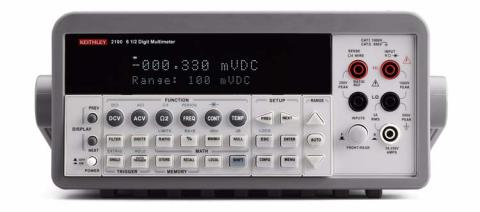
Section 1: General Information |
Model 2100 6 1/2-Digit Resolution Digital Multimeter User’s Manual |
|
|
Introduction
This section contains general information about the Keithley Instruments Model 2100 6 1/2-Digit Resolution Digital Multimeter. The information is organized as follows:
•Feature overview
•Manual addenda
•Precautions for operation
•Upkeep of the Model 2100
•Safety information
•Inspection for damage
•Shipment contents
•Instruction manual
•Repacking for shipment
If you have any questions after reviewing this information, please contact your local Keithley Instruments representative or call one of our Applications Engineers at 1-888-KEITHLEY (1-888-534-8453). You can also contact us through our website at www.keithley.com.
Feature overview
Figure 1-1
The Model 2100 6 1/2-Digit Resolution Digital Multimeter
The Keithley Instruments Model 2100 is a rugged and versatile 6 1/2-digit resolution digital multimeter. It has 0.003% one-year basic DC voltage accuracy at 10V range and 0.005% one-year basic resistance accuracy at 10kΩ range. At 6 1/2 digits, the multimeter delivers 50 triggered RDGS/sec via the USB remote interface. At the fast 4 1/2-digit setting, it reads over 2000 RDGS/ sec into its internal buffer.
•Resolution: 6 1/2 digits
•5x7 dot-matrix VFD, dual displays with 3-color annunciators
•Eleven standard measurement functions and eight math functions
•Stability, accuracy, and speed
•Built-in USB interfaces
•DC voltage: 0.1V, 1V, 10V, 100V, and 1000V
•AC voltage: 0.1V, 1V, 10V, 100V, and 750V
•DC current: 10mA, 100mA, 1A, and 3A
•AC current: 1A, and 3A
•Two and 4-wire resistance: 100Ω, 1KΩ, 10KΩ, 100KΩ, 1MΩ, 10MΩ, and 100MΩ
1-2 |
Return to Section Topics |
2100-900-01 Rev. C / August 2010 |
Model 2100 6 1/2-Digit Resolution Digital Multimeter User’s Manual |
Section 1: General Information |
|
|
•Frequency: From 3Hz to 300kHz
•Period measurement
•Diode measurement
•Continuity measurement for resistance
Some additional capabilities of the Model 2100 include:
•Temperature measurement using RTDs
•Full math functions: dB, dBm, MX+B, ratio, percentage, Max/Min, null, and limits
•TMC compliant USB remote control interface for PC control
•Microsoft® Office Word, and Excel add-in tools for remotely storing and recalling the measured values from these applications
Specifications
Refer to Appendix A of this manual for complete Model 2100 specifications. Check the Keithley Instruments website at www.keithley.com for the latest updates to the specifications.
Manual addenda
Any improvements or changes concerning the Model 2100 or manual will be explained in an addendum included with the manual. Be sure to note these changes and incorporate them into the manual.
Precautions for operation
•Please carefully read the manual before operating this device.
•This manual is for reference only. Please consult your local service representative for further assistance.
•The contents of this manual may be amended by the manufacturer without notice.
•Never allow unauthorized personnel to dismantle the equipment, or equipment may be damaged.
•The equipment has been strictly tested for quality before delivery from our factory.
•Do not use the meter around explosive gas or flammable vapors.
•The patent and related documents for the equipment belong to Keithley Instruments, Inc. and may not be used by others without permission.
Upkeep of the Model 2100
•Although the Model 2100 multimeter is very durable and weather resistant, care should be taken not to expose it to severe impacts or forces.
•Keep the Model 2100 away from water and damp environments.
•Calibration should be performed every year. Please contact your local service representative for more information.
•If an incorrect display or abnormal beeps occur, you should stop using the equipment at once and contact your local service representative.
•Wipe the surface of the Model 2100 multimeter with a dry or damp clean cloth to dust and clean any residue from the enclosure.
2100-900-01 Rev. C / August 2010 |
Return to Section Topics |
1-3 |

Section 1: General Information |
Model 2100 6 1/2-Digit Resolution Digital Multimeter User’s Manual |
|
|
Safety information
WARNING To avoid possible electric shock, personal injury, or death, please read and follow these guidelines carefully:
•Follow the guidelines in this manual and DO NOT use the meter if the case is damaged. Check the meter case and terminals, and make sure all the devices are in the proper positions.
•Do not apply excessive voltage to the multimeter. Apply voltage within the rated range only.
•Use caution when measuring voltages above 30V RMS, 42V peak, or 60V DC. Higher voltages pose an electric shock hazard.
•When using the probes, always keep your fingers behind the finger guards.
•Always connect the common test leads (black) before connecting the live test leads (red), and disconnect the live test leads (red) before disconnecting the common test leads (black). This will reduce the chance of an electric shock.
•Disconnect circuit power and discharge all high-voltage capacitors before testing resistance, continuity, diodes, or capacitance.
•Repairs must only be performed by qualified service personnel.
•When replacing fuses, use only the same type and same rating as specified. Make sure the unit is disconnected from AC power and any external signals first.
•Do not try to operate the meter if it is damaged. Disconnect the power from the equipment and consult your local service representative. Return the product to a Keithley Instruments service facility if necessary.
Safety symbols and terms
The following symbols and terms may be found on the Model 2100 or used in this manual.
The ! symbol indicates that the user should refer to the operating instructions located in the manual.
The  symbol shows that high voltage may be present on the terminal(s). Use standard safety precautions to avoid personal contact with these voltages.
symbol shows that high voltage may be present on the terminal(s). Use standard safety precautions to avoid personal contact with these voltages.
Inspection for damage
The Model 2100 was carefully inspected electrically and mechanically before shipment. After unpacking all items from the shipping carton, check for any obvious signs of physical damage that may have occurred during transit. Report any damage to the shipping agent immediately. Save the original packing carton for possible future shipment.
1-4 |
Return to Section Topics |
2100-900-01 Rev. C / August 2010 |
Model 2100 6 1/2-Digit Resolution Digital Multimeter User’s Manual |
Section 1: General Information |
|
|
Shipment contents
The following items are included with every Model 2100 order:
•One Model 2100 Multimeter unit (112mm/4.4in (H) x 256mm/10.1in (W) x 375/14.75in (D), 4.1Kg/9lbs)
•One power line cord
•One USB cable
•Standard safety test leads
•One CD-ROM (including this electronic User's Manual and software applications)
Instruction manual
A CD-ROM containing this User’s Manual and required software and drivers is included with each Model 2100 order.
Check the Keithley Instruments website at www.keithley.com for the latest revision of the manual. The latest manual can be downloaded (in PDF format) from the website.
Repacking for shipment
Should it become necessary to return the Model 2100 for repair, carefully pack the unit in its original packing carton or the equivalent, and follow these instructions:
•Call the Repair Department at 1-888-KEITHLEY (1-888-534-8453) for a Return Material Authorization (RMA) number.
•Advise as to the warranty status of the Model 2100.
•Write ATTENTION REPAIR DEPARTMENT and the RMA number on the shipping label.
Complete and include the Service Form located at the back of this manual.
2100-900-01 Rev. C / August 2010 |
Return to Section Topics |
1-5 |
Section 1: General Information |
Model 2100 6 1/2-Digit Resolution Digital Multimeter User’s Manual |
|
|
This page left blank intentionally.
1-6 |
Return to Section Topics |
2100-900-01 Rev. C / August 2010 |

Section 2
Getting Started
In this section:
Topic |
Page |
|
|
Overview ............................................................................................. |
2-2 |
Setting up the Model 2100 Digital Multimeter ..................................... |
2-2 |
Adjusting the handle ..................................................................... |
2-2 |
Setting the line voltage ................................................................. |
2-4 |
Connecting the power................................................................... |
2-7 |
Changing the fuses....................................................................... |
2-9 |
Factory default settings ................................................................ |
2-18 |
Model 2100 familiarization .................................................................. |
2-19 |
The front panel.............................................................................. |
2-19 |
The display ................................................................................... |
2-21 |
The rear panel .............................................................................. |
2-23 |

Section 2: Getting Started |
Model 2100 6 1/2-Digit Resolution Digital Multimeter User’s Manual |
|
|
Overview
This section will give you an overview of the Keithley Instruments Model 2100 6 1/2-Digit Resolution Multimeter’s basic features and guide you through the basics of the Model 2100.
Setting up the Model 2100 Digital Multimeter
The purpose of this section is to prepare you to use the Model 2100 Digital Multimeter (DMM). You should check whether you have all the parts needed to operate your multimeter. All Keithley Instruments products are handled and inspected professionally before shipping out to our customers. If you find any damaged or missing parts, please contact your local service representative immediately. Do not attempt to operate a damaged product; if you have any doubt about the condition of your Model 2100, please contact your local service representative.
Adjusting the handle
You may adjust the carrying handle to suit your needs. Figures 2-1, 2-2, 2-3, 2-4, and 2-5 show you how to adjust the handle.
Removing the handle
Step 1: Move the handle to an upright position.
Pull slightly outward on both sides of the handle, and slowly rotate it up as shown in Figure 2-1.
Figure 2-1
Moving the handle to an upright position
Step 2: Remove the handle
When the handle is turned up to a 90° angle with the multimeter, pull it away from the multimeter (refer to Figure 2-2).
2-2 |
Return to Section Topics |
2100-900-01 Rev. C / August 2010 |

Model 2100 6 1/2-Digit Resolution Digital Multimeter User’s Manual |
Section 2: Getting Started |
|
|
Figure 2-2
Removing the handle from the multimeter
|
|
|
|
|
|
|
|
|
CAT |
1000V |
|
|
|
|
|
|
|
|
|
|
CAT |
600V |
|
|
|
|
|
|
|
|
|
|
SENSE |
INPUT |
|
|
|
|
|
|
|
|
|
|
4 WIRE |
V |
|
|
|
|
|
|
|
|
|
|
|
HI |
|
|
|
|
|
|
|
|
|
200V |
RATIO |
|
1000V |
|
|
|
|
|
|
|
|
PEAK |
REF |
|
PEAK |
|
|
|
FUNCTION |
|
|
SETUP |
RANGE |
|
LO |
|
|
PREV |
DCI |
ACI |
4 |
PERIOD |
|
|
|
|
|
|
|
|
|
|
|
|
|
|
|
|
|
|
|
|
|
|
|
|
|
|
|
|
INPUTS |
3A |
500V |
|
|
|
|
|
|
|
|
|
RMS |
PEAK |
|
DISPLAY |
|
|
LIMITS |
MX+B |
dBm |
dB |
LOCK |
|
|
|
|
|
|
|
|
|
|
|
|
F |
|
R |
|
NEXT |
EXTRIG |
HOLD |
|
MATH |
|
|
|
FRONT/REAR |
3A 250V |
|
|
|
|
|
|
|
|
|
AMPS |
|
|||
OFF |
|
|
|
|
|
|
|
|
|
|
|
ON |
|
|
|
|
|
|
|
|
|
|
|
POWER  TRIGGER
TRIGGER 
 MEMORY
MEMORY 
Adjusting the handle position
You can adjust the Model 2100’s handle to suit your needs:
Position 1: Default
The default position is used for packing the Model 2100 (refer to Figure 2-3).
Figure 2-3
Default handle position
Position 2: Operating
The adjusted handle position shown in Figure 2-4 is for multimeter operation.
2100-900-01 Rev. C / August 2010 |
Return to Section Topics |
2-3 |

Section 2: Getting Started |
Model 2100 6 1/2-Digit Resolution Digital Multimeter User’s Manual |
|
|
Figure 2-4
Operation handle position
Position 3: Carrying
The carrying position is shown in Figure 2-5.
Figure 2-5
Carrying position
Setting the line voltage
WARNING Before changing the setting, ensure that the multimeter is disconnected from the AC power.
Step 1: Disconnect AC power
Verify that the meter is disconnected from AC power as shown in Figure 2-6.
2-4 |
Return to Section Topics |
2100-900-01 Rev. C / August 2010 |

Model 2100 6 1/2-Digit Resolution Digital Multimeter User’s Manual |
Section 2: Getting Started |
|
|
Figure 2-6
Disconnecting AC power
Step 2: Open the voltage setting selector
Open the voltage setting selector cap as shown in Figure 2-7 (a flat blade screwdriver may be required).
Figure 2-7
Opening the voltage setting selector
Step 3: Remove the red voltage setting selector
Remove the red voltage selector fuse holder from the right middle seam as shown in Figure 2-8 (a flat blade screwdriver may be required).
2100-900-01 Rev. C / August 2010 |
Return to Section Topics |
2-5 |
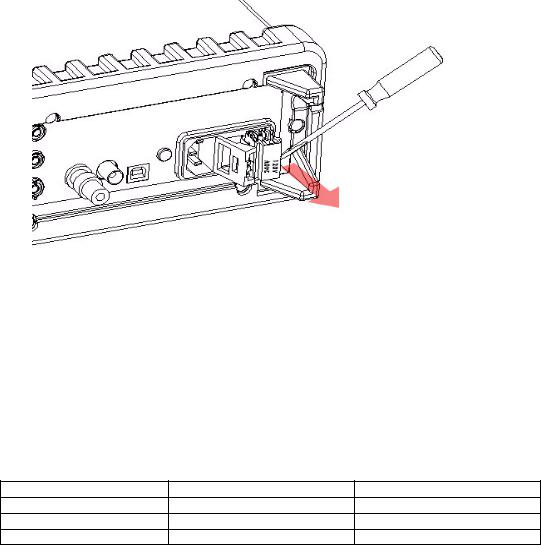
Section 2: Getting Started |
Model 2100 6 1/2-Digit Resolution Digital Multimeter User’s Manual |
|
|
Figure 2-8
Removing the red voltage selector fuse holder
Step 4: Change the voltage setting
Turn the voltage setting to the correct setting.
NOTE To accommodate differing local area power requirements, Keithley Instruments has three available models of voltage setting selectors for the Model 2100 (each with two voltage settings). The voltage setting selector included with your Model 2100 should have the appropriate voltage settings for your area's line power requirements. If you do not have the correct voltage setting selector, please contact your local Keithley Instruments representative to request the correct model (see Table 2-1, below).
Table 2-1
Available voltage setting selectors for local line power requirements
Model number |
Voltage select options |
Voltage set to: |
2100/120 |
120/240 |
120 |
2100/230-240 |
120/240 |
240 |
2100/220 |
120/220 |
220 |
Step 5: Insert the voltage selector
Insert the voltage setting selector back into the socket and close the cap as shown in Figure 2-9.
2-6 |
Return to Section Topics |
2100-900-01 Rev. C / August 2010 |
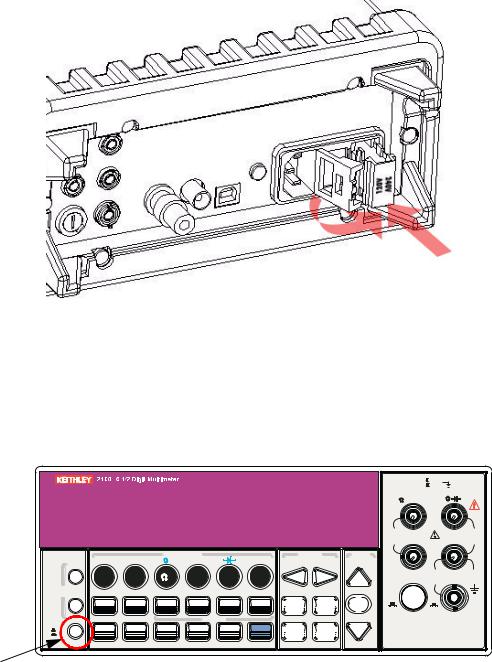
Model 2100 6 1/2-Digit Resolution Digital Multimeter User’s Manual |
Section 2: Getting Started |
|
|
Figure 2-9
Inserting the voltage selector
Connecting the power
Power-off the multimeter
Ensure that the power switch on the front panel is in the "POWER OFF" position before plugging the Model 2100 in (refer to Figure 2-10).
Figure 2-10
Powering-off the multimeter
|
|
|
|
|
|
|
|
|
CAT |
1000V |
|
|
|
|
|
|
|
|
|
|
CAT |
600V |
|
|
|
|
|
|
|
|
|
|
SENSE |
INPUT |
|
|
|
|
|
|
|
|
|
|
4 WIRE |
V |
|
|
|
|
|
|
|
|
|
|
|
HI |
|
|
|
|
|
|
|
|
|
200V |
RATIO |
|
1000V |
|
|
|
|
|
|
|
|
REF |
|
||
|
|
|
|
|
|
|
|
PEAK |
|
PEAK |
|
|
|
|
|
|
|
|
|
|
|
||
|
|
FUNCTION |
|
|
SETUP |
RANGE |
|
LO |
|
||
|
|
|
|
|
|
|
|||||
DCI |
ACI |
4 |
PERIOD |
|
|
|
|
|
|
|
|
PREV |
|
|
|
|
|
|
|
|
|
|
|
DCV |
ACV |
2 |
FREQ |
CONT |
TEMP |
PREV |
NEXT |
|
INPUTS |
3A |
500V |
|
RMS |
PEAK |
|||||||||
DISPLAY |
|
LIMITS |
MX+B |
dBm |
dB |
LOCK |
|
|
|
|
|
FILTER |
DIGITS |
RATIO |
% |
MIN/MAX |
NULL |
ESC |
ENTER |
F |
|
R |
|
AUTO |
|
|
|
||||||||
EXTRIG |
HOLD |
|
MATH |
|
|
|
FRONT/REAR |
3A 250V |
|
||
|
|
|
|
|
|
AMPS |
|
||||
|
|
|
|
|
|
|
|
|
|
|
|
SINGLE |
AUTO |
STORE |
RECALL |
LOCAL |
SHIFT |
CONFIG |
MENU |
|
|
|
|
TRIGGER |
|
|
|
|
|||||||
 TRIGGER
TRIGGER 
 MEMORY
MEMORY 
Plug-in the power cord
After finishing the above procedures, you can plug-in your power cord as shown in Figure 2-11.
2100-900-01 Rev. C / August 2010 |
Return to Section Topics |
2-7 |
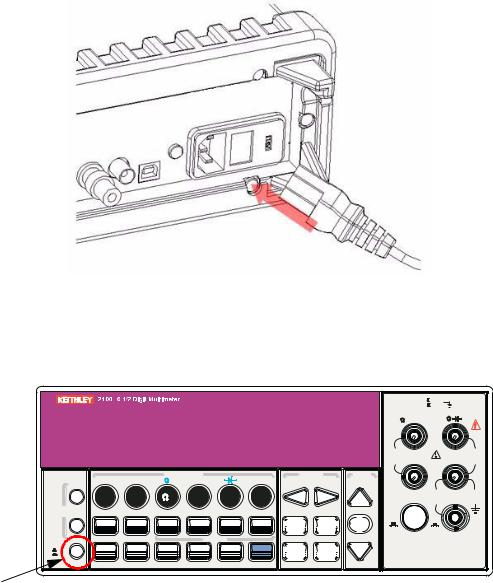
Section 2: Getting Started |
Model 2100 6 1/2-Digit Resolution Digital Multimeter User’s Manual |
|
|
Figure 2-11
Plugging in the power cord
Switch the power on
Press the power switch on the front panel to activate the Model 2100 as shown in Figure 2-12.
Figure 2-12
Switching on the power
|
|
|
|
|
|
|
|
CAT |
1000V |
|
|
|
|
|
|
|
|
|
CAT |
600V |
|
|
|
|
|
|
|
|
|
SENSE |
INPUT |
|
|
|
|
|
|
|
|
|
4 WIRE |
V |
|
|
|
|
|
|
|
|
|
|
HI |
|
|
|
|
|
|
|
|
200V |
RATIO |
|
1000V |
|
|
|
|
|
|
|
REF |
|
||
|
|
|
|
|
|
|
PEAK |
|
PEAK |
|
|
|
|
|
|
|
|
|
|
||
|
|
FUNCTION |
|
|
SETUP |
RANGE |
|
LO |
|
|
|
|
|
|
|
|
|
||||
DCI |
ACI |
4 |
PERIOD |
|
|
|
|
|
|
|
PREV |
|
|
|
|
|
|
|
|
|
|
|
|
|
|
|
|
|
|
INPUTS |
3A |
500V |
|
|
|
|
|
|
|
|
RMS |
PEAK |
|
DISPLAY |
|
LIMITS |
MX+B |
dBm |
dB |
LOCK |
|
|
|
|
|
|
|
|
|
|
|||||
|
|
|
|
|
|
|
F |
|
R |
|
EXTRIG |
HOLD |
|
MATH |
|
|
|
FRONT/REAR |
3A 250V |
|
|
|
|
|
|
|
|
AMPS |
|
|||
|
|
|
|
|
|
|
|
|
|
|
 TRIGGER
TRIGGER 
 MEMORY
MEMORY 
Check the power-line voltage on the rear panel to see if the voltage setting is correct for your area. Change the setting if it is not correct by following the steps in “Setting the line voltage” later in this section.
2-8 |
Return to Section Topics |
2100-900-01 Rev. C / August 2010 |
Model 2100 6 1/2-Digit Resolution Digital Multimeter User’s Manual |
Section 2: Getting Started |
|
|
WARNING Before connecting power to the Model 2100, ensure that the fuse is intact. Refer to “Changing the fuses” later in this section if the fuse is open/blown.
WARNING The main power input voltage to the unit must be selected correctly according to the local installation’s power supply. Check the voltage indication window on the power module at the back of the unit to verify the voltage setting is correctly set. If the voltage is not correctly set, refer to “Setting the line voltage” below.
WARNING The power cord supplied with the Model 2100 contains a separate ground wire for use with grounded outlets. When proper connections are made, the instrument chassis is connected to power line ground through the ground wire in the power cord. Failure to use a grounded outlet may result in personal injury or death due to electric shock.
Changing the fuses
WARNING Before replacing the power-line fuse or current input fuses, verify that the multimeter is disconnected from AC power. You must be qualified personnel to perform this action.
CAUTION For continued protection against fire or instrument damage, only replace the fuses with the same type and rating. If the instrument repeatedly blows fuses, have the unit serviced at an authorized repair facility.
Power line fuse
A power-line fuse located next to the AC receptacle (in the voltage setting selector) protects the power line input of the instrument. Verify that the power-line fuse is good and replace it with a new one if it is damaged. The Model 2100 is shipped from the factory with a 0.25A/250V, 5×20mm slow-blow glass fuse installed (Keithley Instruments part number FU-96-4). This is the correct fuse type for all line voltage settings; use only this type of replacement fuse.
To change the power line fuse:
Step 1: Disconnect the AC power
Verify that the meter is disconnected from AC power as shown in Figure 2-13.
2100-900-01 Rev. C / August 2010 |
Return to Section Topics |
2-9 |

Section 2: Getting Started |
Model 2100 6 1/2-Digit Resolution Digital Multimeter User’s Manual |
|
|
Figure 2-13
Disconnecting the AC power
Step 2: Open the voltage setting selector
Open the voltage setting selector cap as shown in Figure 2-14 (you will need a screwdriver to do so).
Figure 2-14
Opening the voltage setting selector
Step 3: Remove the red voltage setting selector
Remove the red voltage setting selector from the right middle seam as shown in Figure 2-15 (you might need a screwdriver to do so).
2-10 |
Return to Section Topics |
2100-900-01 Rev. C / August 2010 |
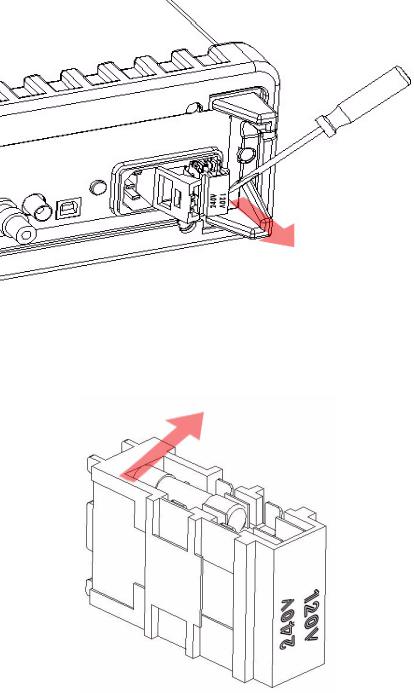
Model 2100 6 1/2-Digit Resolution Digital Multimeter User’s Manual |
Section 2: Getting Started |
|
|
Figure 2-15
Removing the red voltage setting selector
Step 4: Remove the damaged power line fuse
Remove the damaged fuse from the selector as shown in Figure 2-16.
Figure 2-16
Removing the damaged power line fuse
Step 5: Replace the power line fuse
Replace with the new fuse as shown in Figure 2-17.
2100-900-01 Rev. C / August 2010 |
Return to Section Topics |
2-11 |
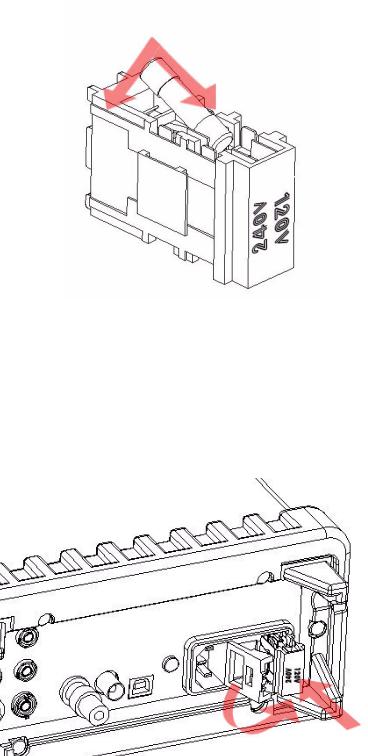
Section 2: Getting Started |
Model 2100 6 1/2-Digit Resolution Digital Multimeter User’s Manual |
|
|
Figure 2-17
Replacing the fuse
Step 6: Reinsert the voltage selector
Insert the voltage setting selector back into the socket and close the cap as shown in Figure 2-18.
CAUTION Verify that the correct voltage setting appears in the red voltage selection window in the power module before powering up the unit. Refer to “Connecting the power” earlier in this section for instructions on how to correctly power up the unit.
Figure 2-18
Reinserting the voltage selector
2-12 |
Return to Section Topics |
2100-900-01 Rev. C / August 2010 |

Model 2100 6 1/2-Digit Resolution Digital Multimeter User’s Manual |
Section 2: Getting Started |
|
|
Current input fuses
The Model 2100 has two 3A fuses in the front and rear current input terminals, and an additional 7A fuse in series with either the front or rear current input fuse (depending on the front or rear panel switch position) for added protection against a strong current pulse. If a strong current pulse overloads the 7A fuse, it will blow quickly, thus saving the 3A fuse and the instrument's internal circuitry (see Figure 2-19).
Figure 2-19
Current protection using 3A and 7A current input fuses in series
The two main fuses located in the front and rear current input terminals of your Model 2100 are 3A, 250V, 5x20mm fast-acting glass fuses (Keithley Instruments part number FU-99-1). The additional current input fuse is a 7A, 250V, 5x20mm fast-acting ceramic tube fuse. See the following text for instructions on how to replace these fuses if they become damaged.
To change the 3A front or rear panel current input terminal fuses:
WARNING Before replacing the power line fuse or current input fuses, verify that the multimeter is disconnected from AC power. You must be qualified personnel to perform this procedure.
CAUTION For continued protection against fire or instrument damage, only replace the fuses with the same type and rating. If the instrument repeatedly blows fuses, have the unit serviced at an authorized repair facility.
NOTE Instructions for replacing the front panel current input terminal fuse are depicted here; the rear panel current input terminal fuse can be changed using the same procedure.
2100-900-01 Rev. C / August 2010 |
Return to Section Topics |
2-13 |

Section 2: Getting Started |
Model 2100 6 1/2-Digit Resolution Digital Multimeter User’s Manual |
|
|
Step 1: Disconnect the AC power
Verify that the meter is disconnected from AC power, as shown in Figure 2-20.
Figure 2-20
Disconnecting the AC power
Step 2: Release the current input terminal fuse holder
Push the current input terminal in and turn it to the right (see Figure 2-21) to release it.
Figure 2-21
Releasing the current input terminal fuse holder
Step 3: Remove the current input terminal fuse holder
Gently pull out the current input terminal fuse holder to expose the current input fuse (see Figure 2-22).
2-14 |
Return to Section Topics |
2100-900-01 Rev. C / August 2010 |
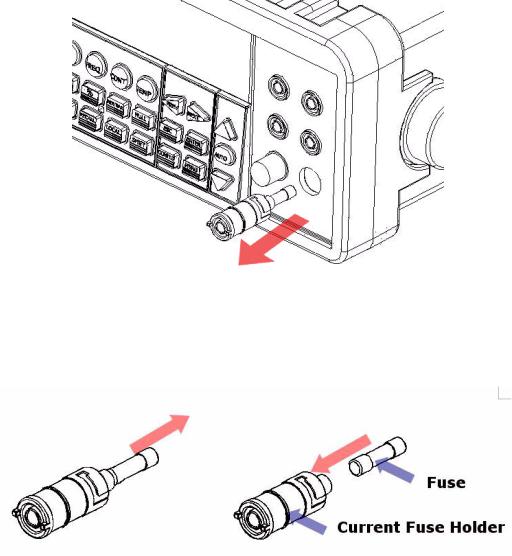
Model 2100 6 1/2-Digit Resolution Digital Multimeter User’s Manual |
Section 2: Getting Started |
|
|
Figure 2-22
Removing the current input terminal fuse holder
Step 4: Remove and replace the damaged fuse
Remove the damaged fuse and replace it with the same type and rating of fuse (see Figure 2-23).
Figure 2-23
Removing and replacing the damaged fuse
Step 5: Reinsert and secure the current input terminal fuse holder
Reinsert the current input terminal fuse holder, turning it to the left as you push it in (see Figure 2-24). Ensure that the fuse holder is properly seated and secured.
2100-900-01 Rev. C / August 2010 |
Return to Section Topics |
2-15 |
